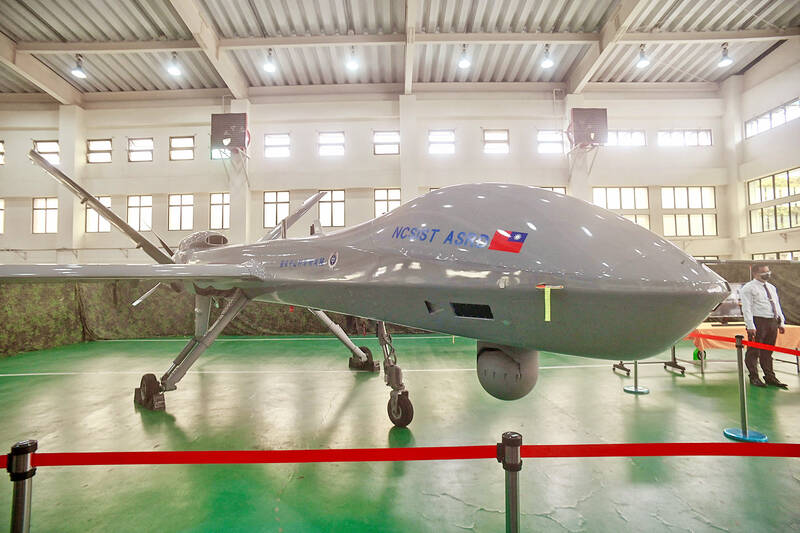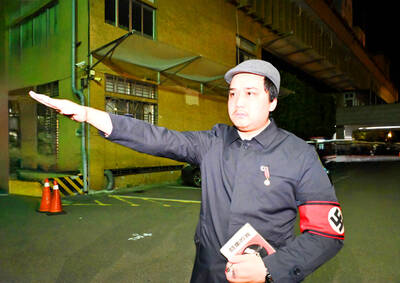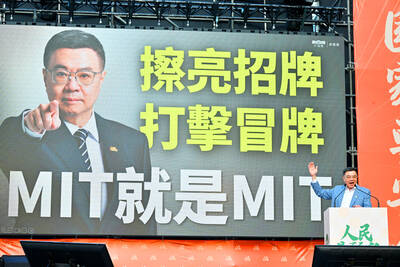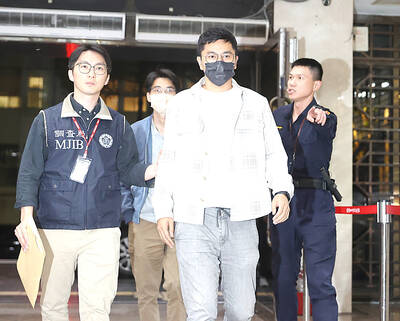Taipei and Washington are pushing for their drone companies to work together to establish a China-free supply chain, the Financial Times reported on Friday.
A delegation of high-level executives and US government officials were yesterday to arrive in Taipei to discuss with their Taiwanese counterparts collaboration on drone technology procurement and development, the report said.
The executives represent 26 US manufacturers of drone and counter-drone systems, while the officials are from the US Department of Commerce and the US Department of Defense’s Defense Innovation Unit, along with Dev Shenoy, principal director for microelectronics in the Office of the Under Secretary of Defense for Research and Engineering, it said.

Photo: Sam Yeh, AFP
China’s dominance in the global drone industry has raised security concerns in the past few years, it said.
The collaboration between Taiwan and the US is part of a broader trend of de-risking supply chains by moving manufacturing away from China, and also highlights Taiwan’s critical role in global supply chains, the Financial Times said.
A key focus of the US delegation is to seek suppliers and manufacturing partners outside of China, it said.
The delegation is “an opportunity for us to become part of their supply chain” and coproduce products, the report quoted Minister of National Defense Wellington Koo (顧立雄) as saying.
“As the US is putting such emphasis on removing China from supply chains and because drones can be dual-use products, a lot of other players will have to integrate their supply chains,” he said.
Other members of the delegation include executives from Dedrone, which supplies counter-drone systems, and defense contractor Northrop Grumman Corp, which has announced plans to expand into the Taiwanese market, the report said.
Taiwan is home to many commercial drone firms, but they are much smaller in scale than their Chinese competitors, and they also focus on smaller machines, it said.
After Russia’s invasion of Ukraine in 2022, Taiwan has sought to build a national “drone team” to support the industry, it said.
Unlike previous partnerships that involved the Ministry of National Defense’s research arm, Chungshan Institute of Science and Technology, the ministry last month announced contracts for military-grade commercial drones totaling NT$6.8 billion (US$US212.75 million).
Taiwan UAV (智飛科技), the nation’s oldest private drone manufacturer, won a contract for more than NT$2.4 billion to supply land-based surveillance drones.
In other developments, the ministry yesterday confirmed that a recent promotional video featured footage of a first-person view (FPV) drone system being developed by the Armaments Bureau.
On Aug. 15, the Military News Agency released footage of soldiers using laptops and remote control equipment to launch small, explosive-laden drones, which detonated upon striking a car and speedboat being used as targets.
FPV drones are piloted from the drone’s point of view through an onboard camera, footage from which is transmitted to a pilot’s monitor or video goggles.
The ministry confirmed in a post on social media that the video showed a multifunction FPV drone system being developed by the bureau.
In addition to the FPV drone program, the military also plans to purchase 3,422 domestically produced microdrones in six different models from this year to 2028, as well as two types of counter-drone systems with 976 missiles between this year and 2026, it said.
Additional reporting by CNA

Seventy percent of middle and elementary schools now conduct English classes entirely in English, the Ministry of Education said, as it encourages schools nationwide to adopt this practice Minister of Education (MOE) Cheng Ying-yao (鄭英耀) is scheduled to present a report on the government’s bilingual education policy to the Legislative Yuan’s Education and Culture Committee today. The report would outline strategies aimed at expanding access to education, reducing regional disparities and improving talent cultivation. Implementation of bilingual education policies has varied across local governments, occasionally drawing public criticism. For example, some schools have required teachers of non-English subjects to pass English proficiency

‘FORM OF PROTEST’: The German Institute Taipei said it was ‘shocked’ to see Nazi symbolism used in connection with political aims as it condemned the incident Sung Chien-liang (宋建樑), who led efforts to recall Democratic Progressive Party (DPP) Legislator Lee Kun-cheng (李坤城), was released on bail of NT$80,000 yesterday amid an outcry over a Nazi armband he wore to questioning the night before. Sung arrived at the New Taipei City District Prosecutors’ Office for questioning in a recall petition forgery case on Tuesday night wearing a red armband bearing a swastika, carrying a copy of Adolf Hitler’s Mein Kampf and giving a Nazi salute. Sung left the building at 1:15am without the armband and apparently covering the book with a coat. This is a serious international scandal and Chinese

TRADE: The premier pledged safeguards on ‘Made in Taiwan’ labeling, anti-dumping measures and stricter export controls to strengthen its position in trade talks Products labeled “made in Taiwan” must be genuinely made in Taiwan, Premier Cho Jung-tai (卓榮泰) said yesterday, vowing to enforce strict safeguards against “origin laundering” and initiate anti-dumping investigations to prevent China dumping its products in Taiwan. Cho made the remarks in a discussion session with representatives from industries in Kaohsiung. In response to the US government’s recent announcement of “reciprocal” tariffs on its trading partners, President William Lai (賴清德) and Cho last week began a series of consultations with industry leaders nationwide to gather feedback and address concerns. Taiwanese and US officials held a videoconference on Friday evening to discuss the

PERSONAL DATA: The implicated KMT members allegedly compiled their petitions by copying names from party lists without the consent of the people concerned Judicial authorities searched six locations yesterday and questioned six people, including one elderly Chinese Nationalist Party (KMT) member and five KMT Youth League associates, about alleged signature forgery and fraud relating to their recall efforts against two Democratic Progressive Party (DPP) legislators. After launching a probe into alleged signature forgery and related fraud in the KMT’s recall effort, prosecutors received a number of complaints, including about one petition that had 1,748 signatures of voters whose family members said they had already passed away, and also voters who said they did not approve the use of their name, Taipei Deputy Chief Prosecutor